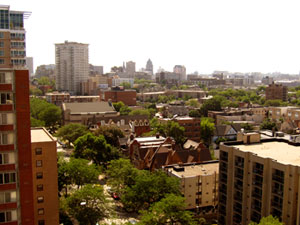Milwaukee has become a model for how to draw residents to Downtown. This city now has more people living downtown than a long list of other mid-sized cities. And despite the temporary slowdown caused by the Great Recession, experts expect the growth in residential population to continue growing for years to come.
In 2000, following the completion of the last U.S. Census, the Brookings Institution studied American downtowns and pegged Milwaukee as one of five (and the only one in the Midwest) with a residential population “on the edge of takeoff.” A couple years prior, in response to a Brookings survey, Milwaukee leaders guessed Downtown’s population would grow to 13,500 by 2010.

It’s beaten that mark, according to a report released earlier this year by Milwaukee’s Downtown Business Improvement District. Downtown population estimates prepared by a GIS consultant say about 15,000 people live in Milwaukee’s Downtown, more than Pittsburgh, Indianapolis, Kansas City, Cleveland, Memphis or Nashville.
Downtown has grown as the entire City of Milwaukee’s population has declined. According to city estimates, the downtown area grew about 50 percent between 1998 and 2006. In the same period, the city’s overall population dropped about 5 percent.
Professor Mark Eppli of the Marquette University Center for Real Estate says the recession has slowed the number of people moving Downtown in the past couple years. “There’s been a net increase in the number of housing units,” he says. “Did we see an increase in the number of households? It’s probably been negligible.”
Eppli expects, however, that Milwaukee’s Downtown boom is only on pause. “In the long term, I believe that trend will continue of people moving back Downtown,” he says.
“There’s still a lot of excitement about living Downtown,” says Mike Ruzicka, president of the Greater Milwaukee Association of Realtors. “But some people who are excited about living Downtown are somewhat frustrated by the lack of new development.”
Milwaukee’s condo-building boom came to almost a total stop in 2008, he says. Condos are still being sold, but apartments have taken over a greater share of the market.
Doughnut holes
In Wichita, Kan., home to about 360,000, city leaders are laying out plans to revitalize their downtown and following the example set by Milwaukee, according to the Wichita Eagle. The newspaper points to Milwaukee’s Riverwalk as a big win: “Its connections between business and entertainment districts and its popular storefronts are a much larger version of what Wichita leaders say they want to grow out of the 20-year revitalization plan currently in the works.”
Nationally, downtown populations rebounded in the 1990s after about 20 years of decline, according to Brookings. Eppli says the perception of cities as polluted and fraught with social unrest drove people out of downtowns beginning in the 1960s, creating a “doughnut hole” in the city’s population. The proliferation of freeways didn’t help, either.
But as neighborhood amenities become more important for buyers and renters than a big house and a spacious backyard, people are moving back downtown, he says. They’re finding it’s cleaner and safer than when they left.
Downtown home ownership, which may at first sound like an oxymoron, is also on the rise, Brookings says. It doubled between 1970 and 2000.
“The majority of the time when people think of moving Downtown, they think of living in a condo,” or renting an apartment, says Realtor Jean Stefaniak of Milwaukee’s Stefaniak Group. But there are a surprisingly large number of single-family homes Downtown, she says, along corridors such as Cass Street and Ogden Avenue.
Downtowners
It’s hard to define downtowns. The Fannie Mae Foundation says they are often “the oldest, most established part of a city” and serve as its central business district. Consequently, they contain the highest rent for commercial office space seen in the city.
In 2008, the city Department of City Development conducted a survey of “downtowners” to prepare for an update of the city’s comprehensive plan for downtown, which is ongoing. Residents were asked to mark why they lived Downtown. The top two answers were “cultural and entertainment venues” and “proximity to lake and/or river.”
Elizabeth Nicols, executive director of the Downtown BID, says the area doesn’t lack for amenities – it just needs publicity. “We have the product. Our biggest challenge is how we convey that we have that product,” she says. “Anybody who visits our city always says it exceeds their expectations.”
As the Wichita Eagle notes of Milwaukee, “It has hung onto its industrial, beer-soaked history while building a future on a plethora of government-backed incentives, a diverse student population and leaders who emphasize the role of architectural design and urban planning.”
But that’s still not enough for some. The Downtown Bid’s survey asked downtowners who only worked in Downtown why they lived elsewhere. The top three responses for suburbanites were schools, backyard size and parking.
by Matt Hrodey.
